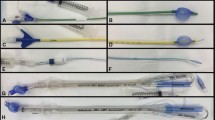Abstract
Thoracic anesthesia encompasses the care of patients undergoing thoracic surgery, as well as patients with diseases of the respiratory system undergoing non-thoracic surgical procedures. This chapter is written with the goal of helping the clinician deliver superb anesthetic care to both of these patient groups. To facilitate understanding this topic, selected concepts of basic respiratory physiology, as well as disease states encountered in patients with lung disease, will be discussed. Finally, the intraoperative management of patients undergoing thoracic surgical procedures will be covered.
Access this chapter
Tax calculation will be finalised at checkout
Purchases are for personal use only
Similar content being viewed by others
Further Reading
Arndt GA, Kranner PW, Rusy DA, Love R. Single-lung ventilation in a critically ill patient using a fiberoptically directed wire-guided endobronchial blocker. Anesthesiology. 1999;90:1484–6.
Beckles MA, Spiro SG, et al. The physiologic evaluation of patients with lung cancer being considered for resectional surgery. Chest. 2003;123:105S–14S.
Brodsky JB, Macario A, Mark JB. Tracheal diameter predicts double-lumen tube size: a method for selecting left double-lumen tubes. Anesth Analg. 1996;82:861–4.
Capan LM, Turndorf H, Patel C, Ramanathan S, Acinapura A, Chalon J. Optimization of arterial oxygenation during one-lung anesthesia. Anesth Analg. 1980;59:847–51.
Centers for Disease Control and Prevention. Chronic obstructive pulmonary disease among adults—United States, 2011. MMWR. 2012;61(46):938–43.
Ferguson MK. Preoperative assessment of pulmonary risk. Chest. 1999;115:58S–63S.
Gaine SP, Rubin LJ. Primary pulmonary hypertension. Lancet. 1998;352:719–25.
Global Initiative for Chronic Obstructive Lung Disease: National Heart, Lung, and Blood Institute/World Health Organization, 2013.
Hedenstierna G, Baehrendtz S, Klingstedt C, et al. Ventilation and perfusion of each lung during differential ventilation with selective PEEP. Anesthesiology. 1984;61:369–76.
Hillman DR, Loadsman JA, et al. Obstructive sleep apnoea and anaesthesia. Sleep Med Rev. 2004;8:459–71.
Nakagawa M, Tanaka H, et al. Relationship between the duration of the preoperative smoke-free period and the incidence of postoperative pulmonary complications after pulmonary surgery. Chest. 2001;120(3):705–10.
Narayanaswamy M, McRae K, Slinger P, et al. Choosing a lung isolation device for thoracic surgery: A randomized trial of three bronchial blockers versus double lumen tubes. Anesth Analg. 2009;108:1097–101.
Szegedi LL, Bardoczky GI, Engelman EE, d’Hollander AA. Airway pressure changes during one-lung ventilation. Anesth Analg. 1997;84:1034–7.
Vegh T, Juhaz M, Szatmari S, et al. Effects of different tidal volumes for one lung ventilation on oxygenation with open chest condition and surgical manipulation: a randomized cross-over trial. Minerva Anesthesiol. 2013;79(1):24–32.
Warner DO, Warner MA, Barnes RD, et al. Perioperative respiratory complications in patients with asthma. Anesthesiology. 1996;85:460–7.
Author information
Authors and Affiliations
Corresponding author
Editor information
Editors and Affiliations
Clinical Review
Clinical Review
-
1.
Factors decreasing functional residual capacity include all, except
-
A.
Change from upright to supine position
-
B.
Obesity
-
C.
Pregnancy
-
D.
Infant compared to an adult
-
A.
-
2.
The FEV1/FVC ratio is decreased in
-
A.
Chronic obstructive pulmonary disease
-
B.
Acute respiratory distress syndrome
-
C.
Sarcoidosis
-
D.
Radiation lung fibrosis
-
A.
-
3.
Normal mixed venous oxygen saturation is (%)
-
A.
60
-
B.
75
-
C.
90
-
D.
100
-
A.
-
4.
Ciliary transport returns to normal within following weeks after cessation of smoking
-
A.
1
-
B.
2
-
C.
4
-
D.
8
-
A.
-
5.
Hypoxic pulmonary vasoconstriction is inhibited by all of the following, except
-
A.
Nitroprusside
-
B.
Diltiazem
-
C.
Propofol
-
D.
Sevoflurane (2 MAC)
-
A.
-
6.
On initiation of single-lung ventilation with a double-lumen endotracheal tube, high peak airway pressures are seen. Your next step would be to
-
A.
Add PEEP to the ventilated lung
-
B.
Add CPAP to the non-ventilated lung
-
C.
Suction the endotracheal tube to clear any secretions
-
D.
Insert a fiberoptic scope
-
A.
-
7.
In an anesthetized patient in the lateral decubitus position with a closed chest, the
-
A.
Nondependent lung is better ventilated and perfused
-
B.
The dependent lung is better ventilated and perfused
-
C.
The dependent lung is better perfused, and the nondependent lung is better ventilated
-
D.
The dependent lung is better ventilated, and the nondependent lung is better perfused
-
A.
-
8.
High-risk patients for lung resection have all the following parameters, except
-
A.
Postoperative predicted FEV1 < 800 ml
-
B.
Postoperative predicted diffusion capacity of carbon monoxide of 80 %
-
C.
PaO2 less than 50 mmHg
-
D.
PaCO2 more than 45 mmHg
-
A.
-
9.
For mediastinoscopy, the pulse oximeter should be placed on the
-
A.
Right hand
-
B.
Left hand
-
C.
Right or left hand
-
D.
Right or left foot
-
A.
-
10.
For single-lung ventilation, advantage of using a bronchial blocker over a double-lumen tube is
-
A.
Patient can be taken to the ICU without changing the endotracheal tube
-
B.
Rapid deflation of the lung
-
C.
Ease of placement
-
D.
Bulky
-
A.
Answers: 1. D, 2. A, 3. B, 4. D, 5. C, 6. D, 7. C, 8. B, 9. A, 10. A
Rights and permissions
Copyright information
© 2015 Springer Science+Business Media New York
About this chapter
Cite this chapter
Campbell, L., Katz, J.A. (2015). Thoracic Anesthesia. In: Sikka, P., Beaman, S., Street, J. (eds) Basic Clinical Anesthesia. Springer, New York, NY. https://doi.org/10.1007/978-1-4939-1737-2_28
Download citation
DOI: https://doi.org/10.1007/978-1-4939-1737-2_28
Publisher Name: Springer, New York, NY
Print ISBN: 978-1-4939-1736-5
Online ISBN: 978-1-4939-1737-2
eBook Packages: MedicineMedicine (R0)




